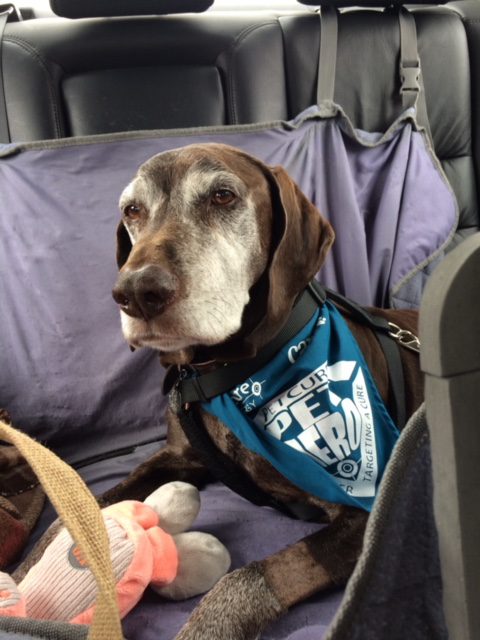What Are The Most Common Types Of Brain Tumors In Dogs?

Brain and tumor are two words you never want to hear your veterinarian say in the same sentence.
But thanks to recent advances in veterinary cancer care, there are new ways we can help dogs with brain cancer. We truly live in a golden age of medicine where clinical capabilities are continually improving. Cancer treatments that were previously only available to humans are now available to our furry family members.
Stereotactic radiation (SRS/SRT) is an advanced form of radiation therapy that is standard in human oncology treatment centers and is available at all affiliated PetCure Oncology locations. SRS/SRT has proven to be one of the most effective ways to treat brain cancer because it is extremely precise and non-surgical. With SRS/SRT, canine brain tumors are targeted with sub-millimeter accuracy to aggressively treat the tumor while protecting the surrounding healthy tissues.
Not every brain tumor is created equal. Read on to learn about signs, symptoms, and the most common types of brain cancer in dogs, as well as treatment options.
Signs & Symptoms of Canine Brain Tumors
Symptoms of a brain tumor in dogs can include:
- Seizures
- Circling in one direction
- Trouble with walking; Appearing “drunk” or unstable
- Decreased cognitive function
- Behavioral changes; Aggression
- Head tilt
- Blindness
- Abnormal pupil size
- Constant or abnormal panting
Note, however, that depending on the type of cancer, a variety of other symptoms can be present including gastrointestinal disturbances, vomiting, weight loss, etc.
What is Canine Meningioma?
Meningioma is the most common type of brain tumor in both dogs and cats. Dogs diagnosed with meningioma have a tumor that occurs in the membranes that line the brain, rather than within the brain cells themselves. Since these tumors are located inside the skull, they can cause pressure on the brain and sometimes invade the brain itself. Most meningiomas are diagnosed as benign or atypical.
What dogs are most susceptible to developing canine meningioma?
Larger breed dogs and those with longer noses or snouts tend to be more susceptible to canine meningioma.
What is Canine Glioma?
Canine glioma is the second most common type of brain cancer in dogs and usually occurs deep within the brain tissue. Gliomas, or cancers of glial origin, can range from low-grade (slow growing) to high-grade (aggressive) tumors. These tumors can be difficult to treat depending on where they are located in the brain.
What dogs are most susceptible to developing canine glioma?
Dogs with shorter noses tend to be more susceptible to canine glioma including boxers and boston terriers.
What is a Canine Choroid Plexus Tumor?
A canine choroid plexus tumor, sometimes referred to as a papilloma, can be either benign or malignant. This type of brain cancer tends to begin in the brain’s ventricular system and can obstruct the drainage of cerebrospinal fluid. The tumors often look like small, red, ulcerative growths. Choroid plexus tumors expand over time and look like a round or cone-shaped protrusion.
What dogs are most susceptible to developing canine choroid plexus papilloma?
Canine choroid plexus papilloma is fairly rare and there is not enough data to indicate a higher incidence of this type of cancer in any particular breed.
What is a Peripheral Nerve Sheath Tumor?
Peripheral Nerve Sheath Tumors (NST’s), also known as Shwannoma, are tumors that originate in the myelin sheath, which surrounds peripheral nerves. The tumors are outside of the central nervous system so they are located on nerves outside of the brain and spinal cord, including:
- Neurofibrosarcomas (malignant nerve fiber tumors)
- Neurofibromas (nerve fiber tumors), and
- Hemangiopericytoma (tumor of blood vessels and soft tissue)
What dogs are most susceptible to peripheral nerve sheath tumors?
Peripheral nerve sheath tumors can occur in all dogs; no breed has been singled out as having a higher risk over others. Some of the symptoms you can look for include, but are not limited to:
- Limb lameness in both fore and hind limbs
- Asymmetry in the muscles of the head
- Palpable mass
- If the tumor is in the neck, only one side of the face will be affected. This may be indicated by a droopy eyelid, paralysis on one side of the face, decreased pupil size and/or a slight elevation of the lower eyelid.
What is Canine Pituitary Adenoma?
Canine pituitary adenoma is a tumor of the pituitary gland, which is a small pea-sized gland located near the base of the brain. The pituitary gland is a tiny organ known for controlling hormones in the body that frequently affect the adrenal gland, thyroid gland and parathyroid gland.
What dogs are most susceptible to developing canine pituitary adenoma?
Certain breeds appear to be predisposed to developing canine pituitary adenoma including Miniature Poodles, Boxers, Boston Terriers, and Dachshunds.
How are canine brain tumors treated?
Dogs with brain cancer can be treated in a variety of ways and treatment options are becoming more sophisticated. Individual treatment recommendations and survival rates depend on the type of cancer, the stage of cancer, its anatomic location and other factors.
- Stereotactic Radiation (SRS/SRT) is an ideal treatment for many brain tumors because it can aggressively and precisely attack a tumor mass without requiring the invasiveness or patient recovery that comes with surgery. Additionally, preliminary data analysis indicates that pets treated with radiation therapy under PetCure-developed treatment protocols are seeing longer survival times than those previously reported in the veterinary literature.
- Surgery is generally considered the most effective way to fully remove a tumor from the body, but it is not typically recommended for brain tumors given the invasiveness of the procedure and delicate location within the body. It is also important to consider whether the entire tumor can be removed without leaving any residual cancer cells behind. If it is unlikely or unclear whether complete surgical removal is possible, treatment of another type will likely also be recommended post-surgery.
- Palliative care is not intended to shrink or stop a tumor’s growth, but can be used to improve cancer-related side effects. For brain tumors, palliative care typically comes in the form of medication intended to alleviate unpleasant symptoms and improve the quality of life that is remaining.
Do you have more questions about brain cancer in dogs?

We’re here for you. We know how scary a brain tumor diagnosis can be. Please reach out to one of our clinically-trained Pet Advocates who can answer your questions about brain tumors, radiation therapy, and other forms of canine and feline cancer. As always, there is no charge for the call.
If your dog has a diagnosed or suspected brain tumor – don’t lose hope. Advances in cancer treatment technology are continually evolving and access to life-changing care options are expanding. Contact PetCure Oncology today by calling us toll-free at 833-738-4376 or emailing Hope@PetCureOncology.com.
